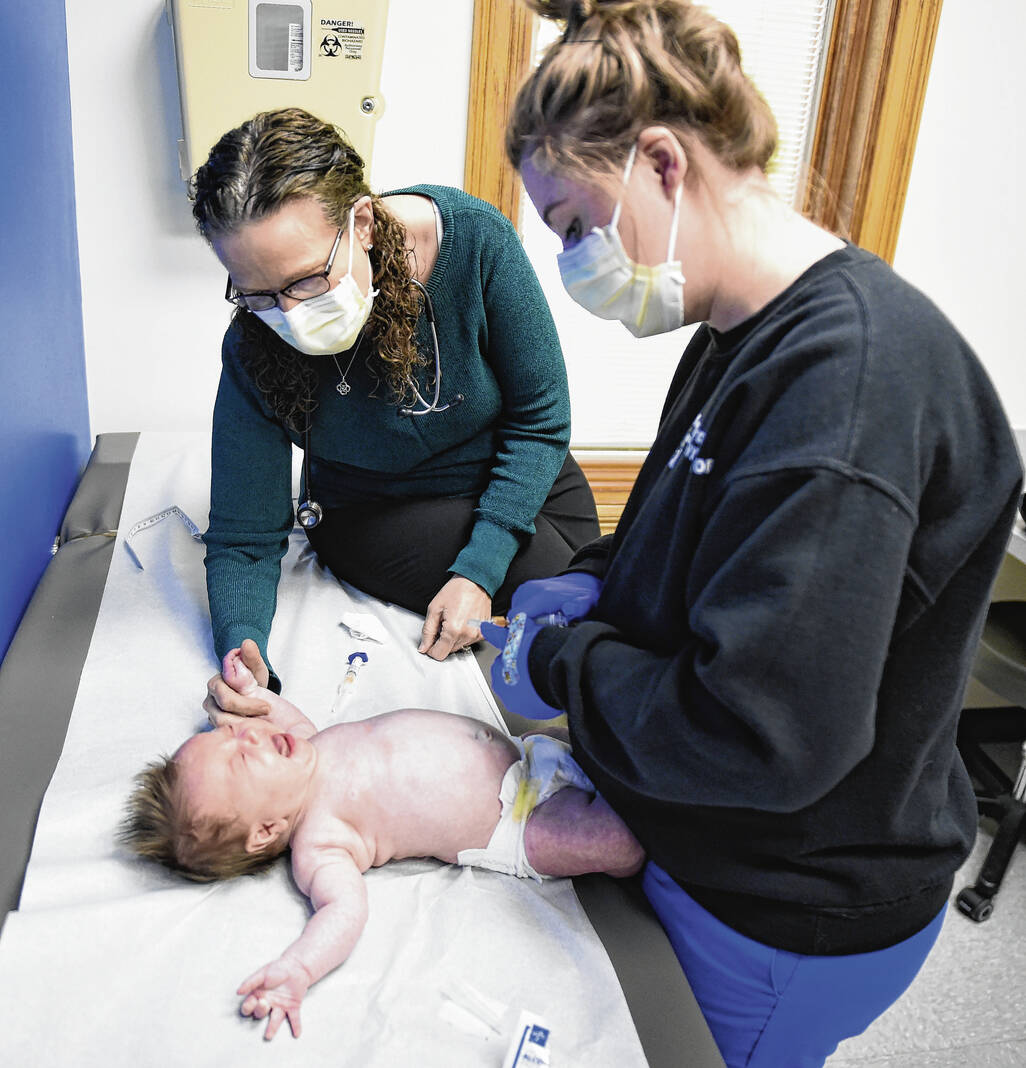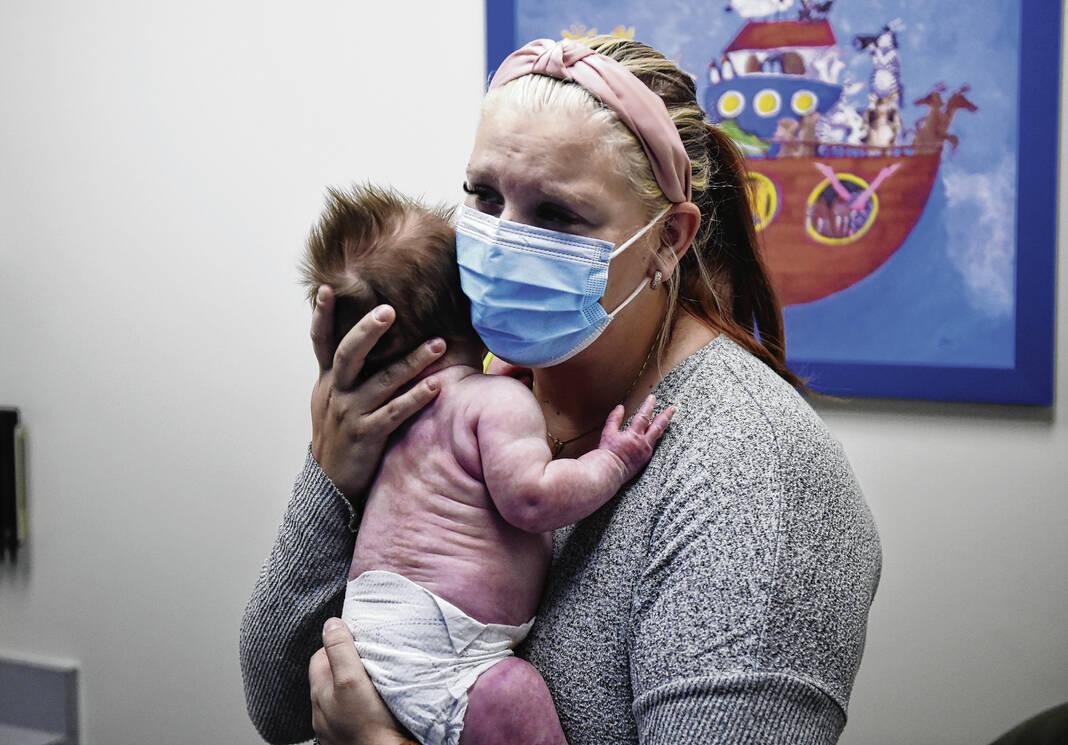In a matter of seconds, the vaccine had been given, the site of the jab sterilized and a bandage deftly place over the wound.
Madison and Tyler West had brought their 8-week-old daughter, Ruby, to Pediatric Associates of Greenwood for her regularly scheduled checkup. As part of that visit, it was time for Ruby to receive a round of vaccinations. Though the tiny newborn wailed at the needle pricks, West knew that it too important to put off.
“I really just want her to be protected in any way possible,” said Madison West, a southside Indianapolis resident. “Our family, we get together often and we travel quite a bit, we go to carnivals, gatherings, all those places. And all of those places have germs, she’s exposed to a lot of things. If it’s available and it can help her in some way, I want make sure she has it.”
Despite that importance, fewer young children across Johnson County and Indiana have received the recommended vaccinations against diseases such as diphtheria, tetanus, polio and measles over the past three years.
Vaccination rates have dropped in the county every year since 2019, as the COVID-19 pandemic wreaked havoc on regular visits to pediatricians and disrupted the established schedules to protect against illness.
Doctors and local health officials are working to reverse that trend by working with parents through education and catching up kids who have fallen behind.
“A lot of pediatricians weren’t seeing them for their regular check-ups for a chunk of time during COVID,” said Dr. Mary Hodson, a pediatrician with Pediatric Associates of Greenwood and Ruby’s doctor. “It was several months before we were allowed to start seeing those kids in our office again. People got out of their routine of coming in for a check-up every year.”
Between the ages of 19 and 35 months, children are recommended to receive an immunization series known as “4:3:1:3:3:1:4.” The numeric series refers to the doses of important vaccines against deadly diseases, as put forth by the Advisory Committee for Immunization Practices, a part of the Centers for Disease Control made up of medical and public health experts that develop recommendations on how to use vaccines.
The vaccines included in that recommendation include those protecting against diphtheria-tetanus-acellular pertussis, polio, measles-mumps-rubella, Haemophilus influenza B, hepatitis B, chicken pox and pneumococcal disease.
“We start immunizing children at a young age because that is when they are most vulnerable to all of these preventable illnesses,” Hodson said. “When their bodies are vulnerable and they don’t have strong immune systems, ways to fight things off, if we vaccinate, we can help them fight things off if they have exposures.”
The Indiana Department of Health tracks the completion of those vaccinations through its statewide immunization registry.
Since 2020, Indiana’s completion rate for those vaccinations have fallen from 70% to 61% in 2021 to 58% this year. In Johnson County over the same time frame, the completion rate has gone from 76% to 67% to 59%, health department data shows.
“Obviously, a huge reason behind that is COVID. That’s definitely taken priority, as people have been staying at home, and once people have been able to be out in the community, we did see a decline in regularly scheduled immunizations,” said Lisa Brown, nursing director for the Johnson County health department. “People were a little fearful not only to come here, but to doctor’s offices.”
The issue is not a local or Indiana problem, but rather a worldwide concern. According to the World Health Organization and UNICEF, with the COVID-19 pandemic sparking the largest sustained decline in childhood vaccinations in approximately 30 years.
“While a pandemic hangover was expected last year as a result of COVID-19 disruptions and lockdowns, what we are seeing now is a continued decline. COVID-19 is not an excuse. We need immunization catch-ups for the missing millions or we will inevitably witness more outbreaks, more sick children and greater pressure on already strained health systems,” said Catherine Russell, UNICEF executive director, in a report released in July 2022.
The Johnson County Health Department offers all vaccines recommended by the Advisory Committee on Immunization Practices. They have seen the decline in childhood vaccination rates, and have worked to correct that trajectory, Brown said.
“One thing we are doing is using the immunization database registry used by the state, and we’re able to run reports, so patients that have been to our health department before, we’re able to reach out to them if we see that they’re behind vaccinations,” she said.
At Hodson’s office, the staff has always followed recommendations by the American Pediatric Association to make sure their patients are up-do-date on their vaccinations, paying close attention to medical records and discussing vaccines with parents during well visits if their children are behind schedule.
During the pandemic, that emphasis became greater, Hodson said.
“In 2020, when practices were closing their doors and not having anyone come in at all, we continued to see all of our children 2 and under for their well visits, because we felt it was so critical that we got them in to get those routine vaccinations,” she said. “So we continued to see those patients, even through the worst of COVID.”
As such, Hodson’s staff have not seen a significant drop-off in those patients ages 2 and under missing or behind on those vaccinations. But where she did see a decrease is with vaccines for kids who were 5, 11 and 16 years old —all ages where vaccines are recommended for different diseases.
Re-establishing those routine visits to the doctor has helped catch kids up on their vaccinations.
“Luckily, the schools are on top of it, telling people they have to get in and get these vaccines. So that’s helping to get them back in again. But we’re finding that some of these kids are little bit behind,” Hodson said.
Still, being behind can be easily correctable.
”Reach out to your pediatrician, reach out to us here at the health department, because we’re able to look and see their record to see if they’re up to date. And if they’re not, we can usually get them scheduled in about a week,” Brown said.
BY THE NUMBERS
Vaccinations completion rates for children ages 19 to 35 months
2022
Johnson County: 59%
Indiana: 58%
2021
Johnson County: 67%
Indiana: 61%
2020
Johnson County: 76%
Indiana: 70%
2019
Johnson County: 76%
Indiana: 70%
2018
Johnson County: 74%
Indiana: 67%
2017
Johnson County: 65%
Indiana: 63%
— Information from the Indiana Department of Health








